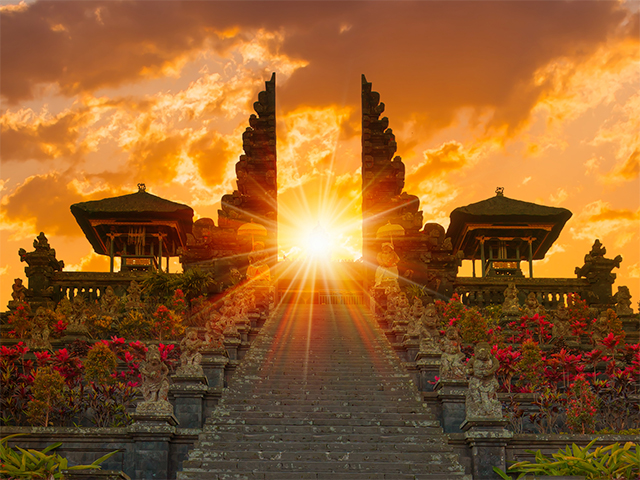Cultural Bali: Harmony of Spirit, Story, and Sacred Tradition

Bali is more than a tropical escape; it's a living tapestry of spirituality, ritual, art, and communal connection. In Bali, religion, cultural expression, and the landscape intertwine beautifully, shaping every gesture, dance, and shrine into an expression of harmony.
Balinese Hinduism: The Spiritual Bedrock
At the heart of Balinese identity lies Agama Hindu Dharma, a unique blend of Vedic Hinduism, animist beliefs, and local tradition. This faith isn't confined to temples, but rather flows through daily life in ritual offerings, community ceremonies, and spiritual architecture. Art, healing, and devotion are inseparable. To experience some of Bali's culture, tourists can often listen to gamelan music, made up of instruments such as drums, gongs, metallophones, flutes, and spike fiddles, observe temple dances, and acts of worship.
Temples, Shrines, and the Sacred Landscape
Temples (pura) are Bali's spiritual and social cores. Whether majestic cliff-edge sea temples like Tanah Lot or humble village shrines, each embodies the belief in maintaining balance between humans and gods, and between nature and community. The subak irrigation system, centered around water temples, is a UNESCO-recognized example of this harmony found in everyday Balinese life.
Balinese architecture also reflects the region's cosmic orientation, with homes and temples aligned with kaja and kelod. These are directional concepts that define space and spirituality, not western directions like north, south, east, and west. Kaja signifies the direction towards the mountains, considered sacred and aligned with the divine. Kelod is the opposite direction, pointing towards the sea and the lower regions, associated with the underworld and negative forces.
Dance, Storytelling & Myth-Making
Balinese culture expresses itself vividly through dance and narrative. These aren't mere shows but are ritual, myth, and communal identity in motion.
- Legong is a graceful, courtly dance performed by girls, with intricate gestures narrating legends and romance.
- Barong is an epic enactment of the eternal struggle between good (Barong) and evil (Rangda), with dramatic masks and storytelling.
- Kecak, known as the "monkey chant," is a trance-like performance featuring a chorus of men chanting "cak-cak" while re-enacting portions of the Ramayana, a Sanskrit poem attributed to the sage Valmiki.
- Pendet is a welcoming dance where young girls scatter flower petals, a symbolic offering that purifies space and invites blessings.
These performances are deeply spiritual, rooted in taksu, which is the divine energy that dancers invoke through offerings and ritual preparation.
Beyond dance, Bali's legends and puppetry (especially Wayang Kulit shadow plays) preserve and transmit moral and cosmological tales. These narratives reinforce communal values, respect for nature, perseverance, humility, and the island's cosmology.
Ritual, Festival & Community
Ceremony is life in Bali. From daily canang sari offerings to grand festivals, worship is inclusive and ongoing. Major festivals include:
- Galungan and Kuningan: celebrated every 210 days, honoring the triumph of good over evil and inviting ancestral spirits back to earth.
- Nyepi (Day of Silence): the Balinese New Year, when the entire island shuts down with no light, and no noise as a spiritual cleanse of body and mind.
- Tumpek Days: held every 35 days, each Tumpek honors aspects of life, including tools, plants, and manuscripts, where offerings and performances are offered to the gods.
During festivals, the community organizes and engages in rituals that range from crafting penjor (decorative bamboo arches) to building and parading Ogoh-ogoh effigies. These effigies are sculptured monstrous art figures that are paraded through the streets expelling spiritual negativity.
Family and community are an integral part of Balinese culture, with young people always participating in festivals and rituals. In one example, young girls perform the sacred Rejang Dewa dance during harvest festivals, displaying a symbol of purity and devotion deeply embedded in family lineage and village life.
Spiritual Connection: Land, Sea & Society
Bali's spirituality is spatial and relational! Mountains, volcanoes, rivers, and trees are sacred and because of this, offerings and shrines appear in fields, homes, and natural settings as a constant reminder to evoke divine spirits. Villages organize life through banjar, community bodies that coordinate rituals, temple maintenance, and mutual support, bridging individual faith with social cohesion.
Why It All Matters
Cultural Bali is defined not by isolated rituals but by the lived integration of art, faith, nature, and community. Every temple visit, dance, or festival connects you to something ancient yet evolving, making Bali a culture that reveres the seen and unseen, and invites participation rather than just observation. Experience Bali, and you don't just witness culture, you become it through the earth, spirit, and human creativity.
Image credit istock / murat4art
Have You Seen This?
MORE








